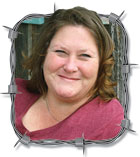A couple of weeks ago, I returned from a speaking engagement at about three in the morning. I would have preferred to “sleep in” the next day, but with calving season still in full swing, I awoke at daylight to feed hay and check the cows. As I drove through the fields at the creek place, I noticed a cow standing off by herself, but with no calf in sight.
I proceeded to the back side of the place where all the rest of the herd was assembled, and unrolled a bale for them. The cow in question joined us as I counted the rest. To me, it was obvious that she had calved, but her udder didn’t appear to have decreased in size. I drove to where I had first seen her.
Under a hedge tree was some afterbirth – but no calf. I got out of the truck and walked in under the thick canopy. Nothing. As I started back toward the truck, I thought I heard a faint, “baah.” The tree was right on the edge of a little spring-fed stream and as I peeked over the edge of the bank I saw a small, black shape about eight feet below. Sure enough, there was a newborn calf that had evidently slid down the muddy embankment into about a foot and a half of cold spring water. The calf, and the pool of water, were covered by no less than three small trees that had toppled over during the ice storm. How was I going to get him out? Was it even worth it, since he had probably been in there since he first attempted to walk and was most likely chilled beyond revival? But his “baah” made him sound like he wanted to live.
I made my way upstream about 50 yards before I found an embankment I could get down. When I reached the baby, I surveyed my options. I could either completely submerse the little guy and pull him out from under the downed trees, or I could try to lift him up through the same opening he fell through to begin with. I chose the latter.
First I grabbed him by his ears to try to get his head started through the hole. I almost had him, but the slick ears (his mother hadn’t even had the chance to lick him completely clean) made me lose my grip and he fell completely below the waterline. He found his footing pretty quickly and re-emerged. This time, I laid across the trees and grabbed a front leg and, after about five minutes of work, had the front half of his little body draped across one of the fallen trees. In another five minutes, I had him out on the graveled edges of the stream. Now, all I had to do was carry him the 50 yards back to the path I had made and then 50 yards back to the truck. By the time I got him to the vehicle, I could have sworn he weighed 200 pounds. I was spent.
It was about 30 degrees outside and I knew the calf needed to spend some time in the floorboard of the truck with the heater on full blast. I opened the door and laid his limp body in the floor of the truck cab. I rested for a few minutes outside while the truck heater operated on high.
Eventually I managed to get into the truck myself, soaking wet and covered with mud and afterbirth; I proceeded toward the herd and the little calf’s mother. Miraculously, the calf came to life when the truck started moving. He was immediately in the passenger seat, and the console, and the dash, and my lap, and everywhere. I should have buckled his seat belt. He was bucking and bawling and thrashing and defecating and urinating on every square inch of a fairly clean farm truck. When we reached the herd, all I had to do was open the door and the little black calf jumped out as if I had opened the chute gate at a PBR event. He ran toward the herd and began trying to suckle any cow that would stand still for him. With all the cows lined up, eating hay, I’m sure he thought he had found the buffet at cows-R-us, but it took the little guy an hour of being kicked and butted away before finding his momma and sucking her dry.
Both calf and cow are doing fine and showing no ill effects from the adventures of that day. The detailer at the car wash, on the other hand, got a little queasy when I informed him of what he was cleaning off the seats, dash, air vents and floorboard.
Jerry Crownover is a farmer and former professor of Agriculture Education at Missouri State University. He is a native of Baxter County, Arkansas, and an author and professional speaker. To contact Jerry about his books, or to arrange speaking engagements, you may contact him by calling 1-866-532-1960 or visiting www.ozarksfn.com and clicking on 'Contact Us.'





